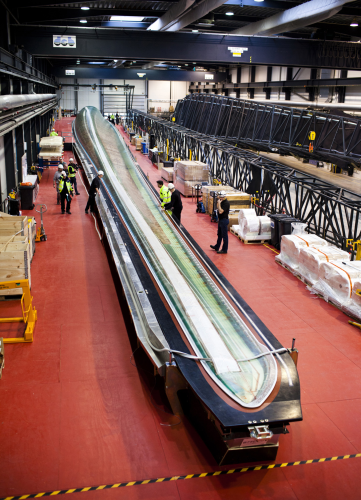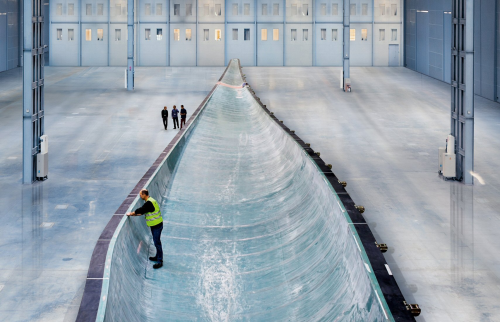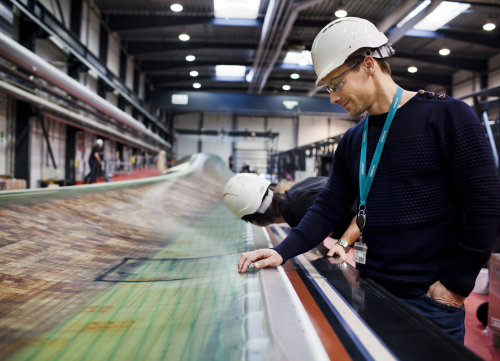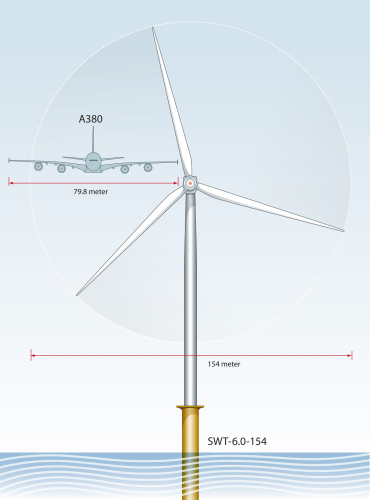



The 75 m ‘B75 Quantum’ blades will be installed on the second prototype of Siemens' 6 MW offshore wind turbine, which will be erected later this year in Denmark's Østerild Test Station.
According to Siemens, the B75 Quantum blade demonstrates tremendous strength at a low weight and, thanks to its unique airfoils, offers superior performance at a wide range of wind speeds. If the blade were produced using traditional technology, it would be 25-50% heavier, the company notes.
Siemens believes the B75 blade is the world's largest fibreglass component to be moulded in one piece.
IntregralBlade process
The 75 m blades are manufactured using Siemens patented IntegralBlade technology. The blades are made of glass reinforced epoxy resin and manufactured in one piece using a closed mould process. The glass fibre reinforcement is laid out in a special moulding arrangement with a closed outer mould and an expanding inner mould. The epoxy resin is injected under a vacuum. The blade is cured at a high temperature whilst in the mould. The blade is then removed from the outer mould, and the inner mould is collapsed with a vacuum and pulled from the blade. The result is a complete, seamless blade.
Compared with the processes used by other blade manufacturers, which generally involve glueing the blades together from a number of spars and shells, the IntegralBlade process has several advantages, Siemens says. The process is efficient in manpower and space, requiring only one mould set for the manufacturing cycle. Additionally, there are no issues relating to tolerances between shells and spars. The resulting blade is an integrated structure offering both low weight and enormous strength, with no glued joints that act as weak points potentially exposing the structure to cracking, water ingress and lightning.
Since the IntegralBlade manufacturing process is a closed mould process, the blade factory offers a clean working environment and the emission of volatile organic compounds (VOCs) is eliminated.
| The latest turbine from Siemens has a 6 MW capacity, with a rotor diameter of 154 m and a swept area of 18 600 m2 – equivalent to almost two and a half soccer fields. |
The company says that this process makes the blades more robust. However, it says the manufacturing process posed several challenges for the B75 project team. In particular, the mould had to consist of two parts so that it could be transported.
When the blades were ready for painting, a special vehicle transported the blades over a distance of 575 km from the blade factory in Aalborg, Denmark, to the Danish town of Nakskov on Lolland Island. In Nakskov the blades were painted – the painting cabin at the blade factory is currently limited to 58 m blade length.
6 MW offshore turbine
The latest turbine from Siemens has a 6 MW capacity, with a rotor diameter of 154 m and a swept area of 18 600 m2 – equivalent to almost two and a half soccer fields. When operating at 10 m/s wind speed the 154 m rotor extracts energy from 200 tons of air per second.
The 6 MW turbine is based on Siemens direct drive technology. As a result, the number of rotating and wear-prone parts is far less than a comparable geared machine and lower maintenance requirements. With a towerhead mass of less than 60 tons per MW the turbine offers significant cost benefits in terms of substructure requirements, shipping and installation.
The launch of the new 75 m blade signifies a 200-fold growth in the energy capture area and the turbine capacity of Siemens’ turbine products over the last 30 years. The company’s first commercial wind turbine had a capacity of 30 kW and 5 m long blades, for a 10 m rotor diameter. ♦
This feature was published in the July/August 2012 issue of Reinforced Plastics magazine.





